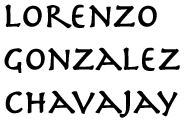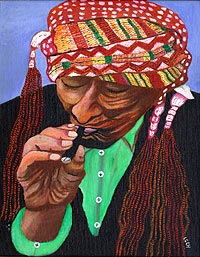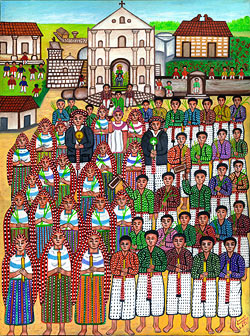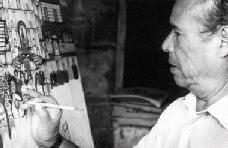| . | |
 |
|
| . | |
| . | |
 |
|
| . | |
|
LINKS TO SECTION PAGES |
|
| . | |
| What good luck! The
proprietor of a tiny San Francisco shop was unpacking a
box from his most recent trip to Guatemala just as I
arrived, and there among the Guatemalan weavings and
tourist art were two oil paintings which were obviously
from San Pedro la Laguna. But who had painted them? I had
been visiting San Pedro since 1985 when I became
interested in the Mayan painters of the town, but
surprisingly, I had never seen paintings by this artist.
The work was naive, strong, and tropical, different in
feeling from work of the other painters with whom I was
familiar. The shopkeeper was delighted to find a potential buyer for these paintings, but couldn't shed any light on its creator--while visiting Lake Atitlán he had bought them from the owner of one of the art galleries frequented by tourists. As I left the shop with the paintings tucked securely under my arm, I was determined to find this artist who signed his paintings LGCh., no matter how long it took. When I returned to San Pedro six months later, my search was thrown off track by misinformation supplied by a local artist I had met on a previous trip. He told me that LGCh. was the signature of his eight-year-old daughter whom he was encouraging to paint. Pleased to know the identity of the mysterious artist, I bought all the paintings of hers in the local gallery, and returned to San Francisco to tell my friends about the talented child. Only after a San Pedro woodcarver took me to the house of sixty-four-year-old Lorenzo Gonzalez Chavajay the following year did I realize, to my embarassment, that I had been fooled. It had taken me nearly two years to learn the truth. After hearing me relate my story, Lorenzo laughed, but immediately re-signed all his paintings with his full name to prevent future ambiguity. |
|
| . | |
 |
|
| . | |
| Lorenzo González Chavajay
is notable for his naive style. Neither closely related
to, nor influenced by, the paintings of the other
artists, Lorenzo is a true autodidact. After retiring at
age fifty-five from his job as municipal treasurer in San
Pedro, he took up drawing in pencil to occupy his time.
With no concept of even the most basic conventions of
drawing, he kept making childlike mistakes. When a friend
persuaded him to try using oil paint, his work came alive
as if by magic. His paintings are pure color, full of light, and as brilliant as the traditional Guatemalan textiles. He patiently depicts his fellow Indians and makes the clothes of each person in a picture different. Every Mayan town has a unique style of dress including distinctive patterns and color combinations. Within the framework of her village's tradition each weaver makes subtle variations in each piece she creates. Even though it takes more time Lorenzo enjoys painting these subtle differences in pattern and color. Sometimes in Lorenzo's paintings the dress of the Pedrano men and women creates a wonderful effect, almost pointillist in nature. Lorenzo's faces, especially those of women, are particularly beautiful and sympathetic. Their dark eyes look directly out of the painting. Almost all people are painted frontally, as though they were posing for a photograph. Even in the midst of great activity, the people Lorenzo paints look stiff, perhaps more so because of his habit of drawing the figures first on paper and then cutting them out and tracing their outlines on the canvas. He saves these cutouts, and may use a person or group in more than one painting. Lorenzo paints his backgrounds, trees and buildings directly onto the canvas without help of patterns. For the sky, he may dab in the painting the striking changes of clouds that occur around the mountains. He usually arranges objects in geometric and symmetrical order, placing trees, plants, houses, and even people in rows, depicting depth by dividing space into horizontal bands. But with no shadows and a minimum of shading, his paintings are essentially two dimensional scenes whose strength lies in the brightness and clarity of their hues and their rhythmic patterning. Light colors contrast with dark, and the dense repetitions of simple designs on the Guatemalan costumes are sometimes a jarring counterpoint to the flat style of the rest of the painting. Layers of yellow, blue, and brown may be used over and under background colors such as green give those colors areas a natural richness. |
|
| . | |
 |
|
| . | |
| Lorenzo, being older than
the other local artists, remembers the vanishing
traditions and puts memorable events from his life into
his paintings. Procesión, Día de Concepción shows
a procession of one of the six religious guilds, or cofradías,
of the Catholic Church in San Pedro. Four young men carry
a platform with the image of the saint, the women carry
candles, and other men carry the staffs with symbols of
the guild. The cofradías disappeared from San
Pedro before 1970. Other remembrances he captures in his paintings are the masked dances, traveling musicians from Nahualá, the courtship of girls carrying water from the lake, the kissing a grandparent's hand as a sign of respect, and the old style huipiles (traditional hand-woven blouses) of the women of San Juan. In refining his art, Lorenzo has followed his own spirit, learning from his own mistakes. At all times his studio wall is alive with paintings, and as long as they are on his walls, he cannot help modifying them. He touches them continually to see if the paint has dried. In recent works, his houses may have remained stick-like, but the patterns he paints on the traditional dress have become more complex and varied. Lorenzo's pictures are not appreciated by other Pedrano artists. One told him that his paintings were good for nothing: "Su trabajo no sirve." Considering his inaccurate perspective, mistakes in the relative size of objects, and the stiffness of his figures, one might dismiss his small paintings as the work of just another minor artist. But Lorenzo's larger canvases, by allowing him to increase the scale and complexity of his unique tapestry of patterns and colors, reveal the power of his compositions. Lorenzo presents his artistic vision in an unique, autodidactic approach. He paints a Guatemala of his younger years but his work transcends nostalgia to appeal to the contemporary eye. He conveys better than any other painter the Mayan love of color and pattern. Perhaps his work will help promote appreciation and preservation of indigenous customs and culture. |
|
| . | |
| LINKS TO SECTION PAGES |
|
|
To contact us write: Arte Maya Tz'utuhil, P.O. Box 40391, San
Francisco, CA 94140. Telephone: (415) 282-7654.
Email me at
All paintings and photographs Copyright © 1988–2015 Arte Maya Tz'utuhil |